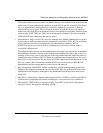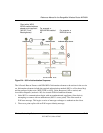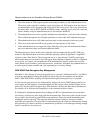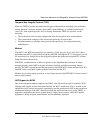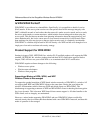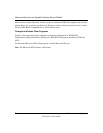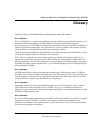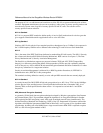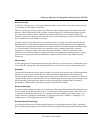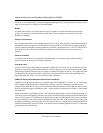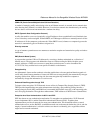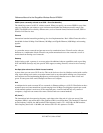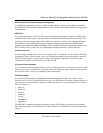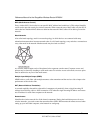
Reference Manual for the RangeMax Wireless Router WPN824
Glossary
1
202-10072-01, March 2005
Glossary
Use the list below to find definitions for technical terms used in this manual.
802.11 Standard
802.11, or IEEE 802.11, is a type of radio technology used for wireless local area networks (WLANs). It is a
standard that has been developed by the IEEE (Institute of Electrical and Electronic Engineers),
http://standards.ieee.org
. The IEEE is an international organization that develops standards for hundreds of
electronic and electrical technologies. The organization uses a series of numbers, like the Dewey Decimal
system in libraries, to differentiate between the various technology families.
The 802 subgroup (of the IEEE) develops standards for local and wide area networks with the 802.11 section
reviewing and creating standards for wireless local area networks.
Wi-Fi , 802.11, is composed of several standards operating in different radio frequencies: 802.11b is a
standard for wireless LANs operating in the 2.4 GHz spectrum with a bandwidth of 11 Mbps; 802.11a is a
different standard for wireless LANs, and pertains to systems operating in the 5 GHz frequency range with a
bandwidth of 54 Mbps. Another standard, 802.11g, is for WLANS operating in the 2.4 GHz frequency but
with a bandwidth of 54 Mbps.
802.11a Standard
An IEEE specification for wireless networking that operates in the 5 GHz frequency range (5.15 GHz to
5.85 GHz) with a maximum 54 Mbps data transfer rate. The 5 GHz frequency band is not as crowded as the
2.4 GHz frequency, because the 802.11a specification offers more radio channels than the 802.11b. These
additional channels can help avoid radio and microwave interference.
802.11b Standard
International standard for wireless networking that operates in the 2.4 GHz frequency range (2.4 GHz to
2.4835 GHz) and provides a throughput of up to 11 Mbps. This is a very commonly used frequency.
Microwave ovens, cordless phones, medical and scientific equipment, as well as Bluetooth devices, all work
within the 2.4 GHz frequency band.
802.11d Standard
802.11d is an IEEE standard supplementary to the Media Access Control (MAC) layer in 802.11 to promote
worldwide use of 802.11 WLANs. It will allow access points to communicate information on the
permissible radio channels with acceptable power levels for client devices. The devices will automatically
adjust based on geographic requirements.



